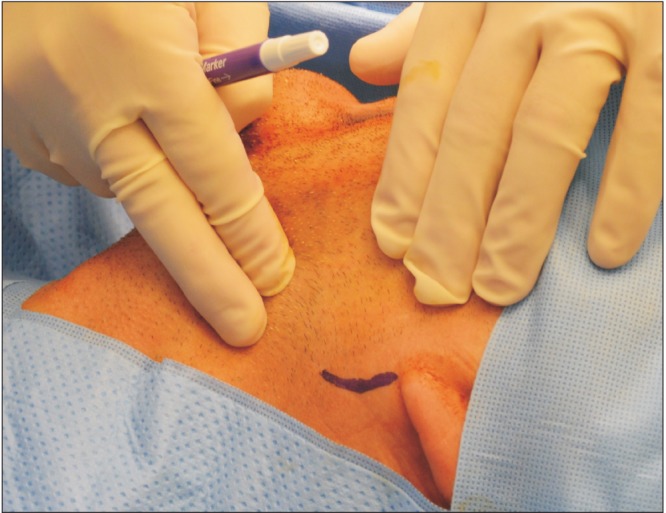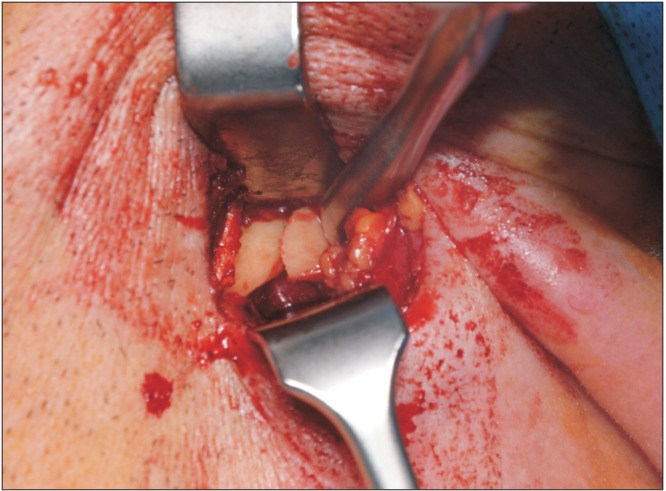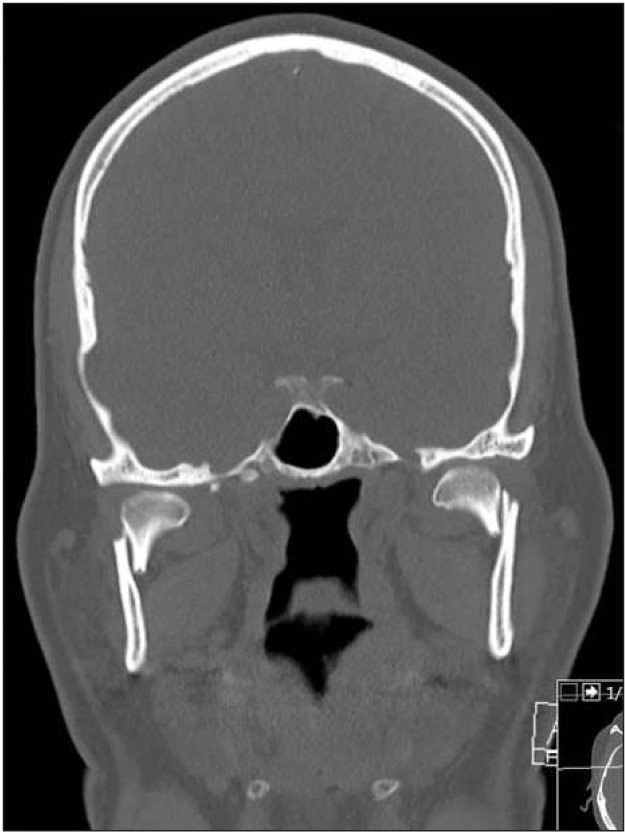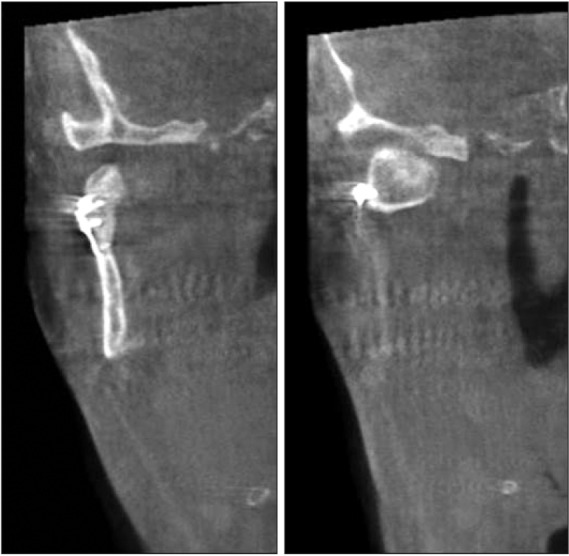J Korean Assoc Oral Maxillofac Surg.
2018 Apr;44(2):73-78. 10.5125/jkaoms.2018.44.2.73.
Complications of the retromandibular transparotid approach for low condylar neck and subcondylar fractures: a retrospective study
- Affiliations
-
- 1Department of Oral and Maxillofacial Surgery, ETZ Hospitals, Tilburg, The Netherlands. jeroen@vanhevele.be
- KMID: 2410583
- DOI: http://doi.org/10.5125/jkaoms.2018.44.2.73
Abstract
OBJECTIVES
The goal of this study was to evaluate the rates of complications, morbidity, and safety with the transparotid approach.
MATERIALS AND METHODS
A retrospective study was conducted and consisted of 53 surgically treated patients in the past five years for low condylar neck and subcondylar fractures. Only patients with malocclusion and who underwent open reduction with internal fixation with the retromandibular transparotid approach were included. The examined parameters were postoperative suboptimal occlusion, deflection, saliva fistula, and facial nerve weakness.
RESULTS
Fifty-three patients had an open reduction with internal fixation on 55 sides (41 males, 77.4%; mean age, 42 years [range, 18-72 years]). Four patients (7.5%) experienced transient facial nerve weakness of the marginal mandibular branch, but none was permanent. Four patients had a salivary fistula, and 5 patients showed postoperative malocclusion, where one needed repeat surgery after one year. One patient showed long-term deflection. No other complications were observed.
CONCLUSION
The retromandibular transparotid approach is a safe procedure for open reduction and internal fixation of low condylar neck and subcondylar fractures, and it has minimal complications.
MeSH Terms
Figure
Cited by 1 articles
-
Direct transparotid approach via a modified mini-preauricular incision for open reduction and internal fixation of subcondylar fractures
Jung-Soo Lee, Sang-Hoon Kang
J Korean Assoc Oral Maxillofac Surg. 2021;47(4):327-334. doi: 10.5125/jkaoms.2021.47.4.327.
Reference
-
1. Bos RR, Ward Booth RP, de Bont LG. Mandibular condyle fractures: a consensus. Br J Oral Maxillofac Surg. 1999; 37:87–89. PMID: 10371306.2. Ellis E 3rd, Moos KF, el-Attar A. Ten years of mandibular fractures: an analysis of 2,137 cases. Oral Surg Oral Med Oral Pathol. 1985; 59:120–129. PMID: 3856795.
Article3. Worsaae N, Thorn JJ. Surgical versus nonsurgical treatment of unilateral dislocated low subcondylar fractures: a clinical study of 52 cases. J Oral Maxillofac Surg. 1994; 52:353–360. discussion 360-1. PMID: 8133366.
Article4. Brandt MT, Haug RH. Open versus closed reduction of adult mandibular condyle fractures: a review of the literature regarding the evolution of current thoughts on management. J Oral Maxillofac Surg. 2003; 61:1324–1332. PMID: 14613090.
Article5. Palmieri C, Ellis E 3rd, Throckmorton G. Mandibular motion after closed and open treatment of unilateral mandibular condylar process fractures. J Oral Maxillofac Surg. 1999; 57:764–775. discussion 775-6. PMID: 10416622.
Article6. Croce A, Moretti A, Vitullo F, Castriotta A, Rosa de M, Citraro L. Transparotid approach for mandibular condylar neck and subcondylar fractures. Acta Otorhinolaryngol Ital. 2010; 30:303–309. PMID: 21808452.7. Hackenberg B, Lee C, Caterson EJ. Management of subcondylar mandible fractures in the adult patient. J Craniofac Surg. 2014; 25:166–171. PMID: 24406572.
Article8. Kellman RM, Cienfuegos R. Endoscopic approaches to subcondylar fractures of the mandible. Facial Plast Surg. 2009; 25:23–28. PMID: 19206025.
Article9. Schubert W, Jenabzadeh K. Endoscopic approach to maxillofacial trauma. J Craniofac Surg. 2009; 20:154–156. PMID: 19165014.
Article10. Zide MF, Kent JN. Indications for open reduction of mandibular condyle fractures. J Oral Maxillofac Surg. 1983; 41:89–98. PMID: 6571887.
Article11. Bouchard C, Perreault MH. Postoperative complications associated with the retromandibular approach: a retrospective analysis of 118 subcondylar fractures. J Oral Maxillofac Surg. 2014; 72:370–375. PMID: 24075238.12. Ellis E 3rd. Condylar process fractures of the mandible. Facial Plast Surg. 2000; 16:193–205. PMID: 11802368.
Article13. Yang L, Patil PM. The retromandibular transparotid approach to mandibular subcondylar fractures. Int J Oral Maxillofac Surg. 2012; 41:494–499. PMID: 22169168.
Article14. Ellis E 3rd, McFadden D, Simon P, Throckmorton G. Surgical complications with open treatment of mandibular condylar process fractures. J Oral Maxillofac Surg. 2000; 58:950–958. PMID: 10981974.
Article15. Chossegros C, Cheynet F, Blanc JL, Bourezak Z. Short retromandibular approach of subcondylar fractures: clinical and radiologic long-term evaluation. Oral Surg Oral Med Oral Pathol Oral Radiol Endod. 1996; 82:248–252. PMID: 8884820.16. Bindra S, Choudhary K, Sharma P, Sheorain A, Sharma CB. Management of mandibular sub condylar and condylar fractures using retromandibular approach and assessment of associated surgical complications. J Maxillofac Oral Surg. 2010; 9:355–362. PMID: 22190824.
Article17. Biglioli F, Colletti G. Mini-retromandibular approach to condylar fractures. J Craniomaxillofac Surg. 2008; 36:378–383. PMID: 18599302.
Article18. Ellis E 3rd, Dean J. Rigid fixation of mandibular condyle fractures. Oral Surg Oral Med Oral Pathol. 1993; 76:6–15. PMID: 8351124.
Article19. Devlin MF, Hislop WS, Carton AT. Open reduction and internal fixation of fractured mandibular condyles by a retromandibular approach: surgical morbidity and informed consent. Br J Oral Maxillofac Surg. 2002; 40:23–25. PMID: 11883965.20. Troulis MJ, Ramirez JL, Kaban LB. Endoscopic approach for mandibular orthognathic surgery. Facial Plast Surg Clin North Am. 2006; 14:45–50. PMID: 16466983.
Article21. Kim BK, Kwon YD, Ohe JY, Choi YH, Choi BJ. Usefulness of the retromandibular transparotid approach for condylar neck and condylar base fractures. J Craniofac Surg. 2012; 23:712–715. PMID: 22565884.
Article22. Shi D, Patil PM, Gupta R. Facial nerve injuries associated with the retromandibular transparotid approach for reduction and fixation of mandibular condyle fractures. J Craniomaxillofac Surg. 2015; 43:402–407. PMID: 25600628.
Article23. Son JH, Ha J, Cho YC, Sung IY. Are biodegradable plates applicable in endoscope-assisted open reduction and internal fixation of mandibular subcondyle fractures? J Oral Maxillofac Surg. 2017; 75:1706–1715. PMID: 28453951.
Article24. Widmark G, Bågenholm T, Kahnberg KE, Lindahl L. Open reduction of subcondylar fractures. A study of functional rehabilitation. Int J Oral Maxillofac Surg. 1996; 25:107–111. PMID: 8727580.
- Full Text Links
- Actions
-
Cited
- CITED
-
- Close
- Share
- Similar articles
-
- Direct transparotid approach via a modified mini-preauricular incision for open reduction and internal fixation of subcondylar fractures
- Case Report of Transparotid Approach of Mandibular Subcondylar Fracture
- Modified high-submandibular appraoch for open reduction and internal fixation of condylar fracture: case series report
- Transmasseteric antero-parotid facelift approach for open reduction and internal fixation of condylar fractures
- Post operative evaluation for retromandibular approach of subcondylar fractures





